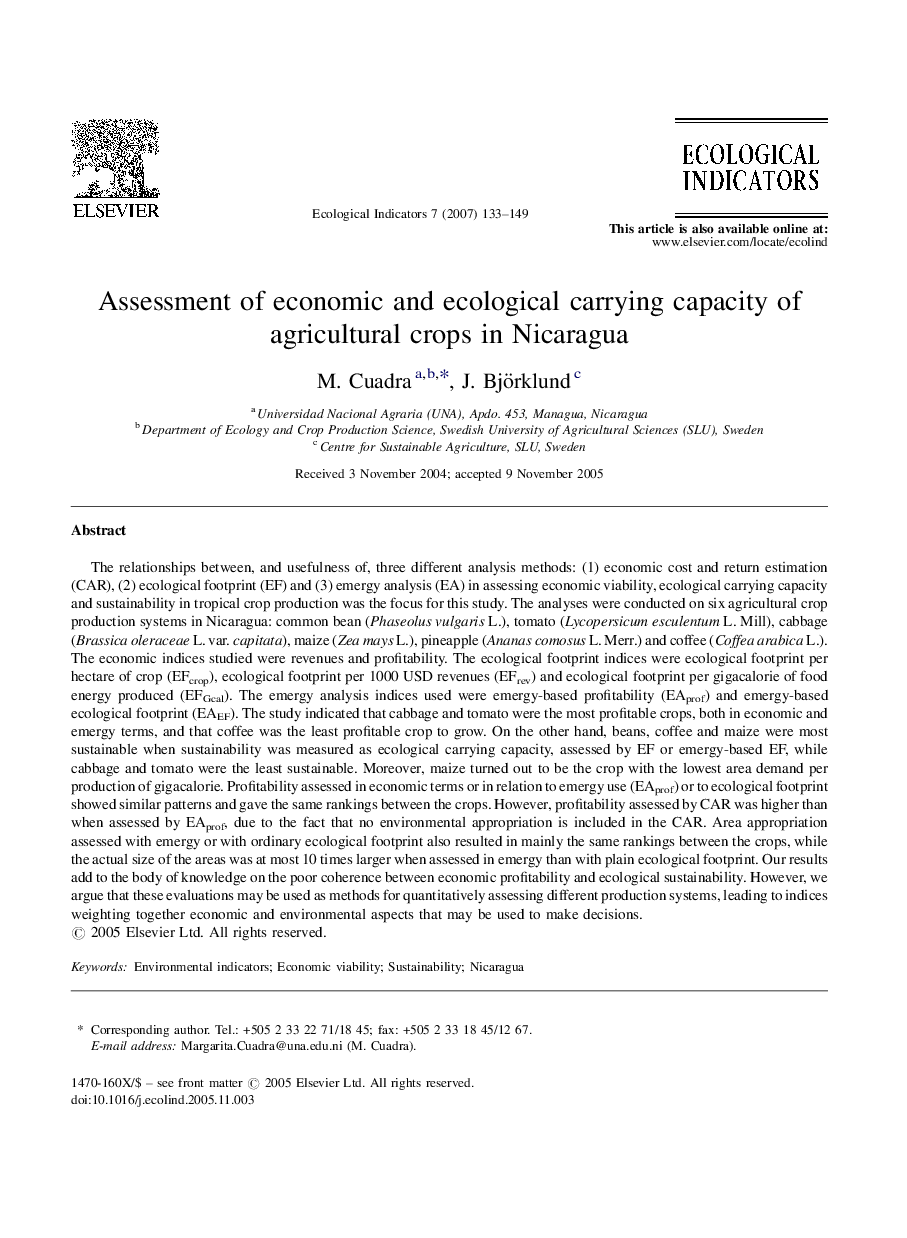| کد مقاله | کد نشریه | سال انتشار | مقاله انگلیسی | نسخه تمام متن |
|---|---|---|---|---|
| 4374644 | 1303185 | 2007 | 17 صفحه PDF | دانلود رایگان |
عنوان انگلیسی مقاله ISI
Assessment of economic and ecological carrying capacity of agricultural crops in Nicaragua
دانلود مقاله + سفارش ترجمه
دانلود مقاله ISI انگلیسی
رایگان برای ایرانیان
کلمات کلیدی
موضوعات مرتبط
علوم زیستی و بیوفناوری
علوم کشاورزی و بیولوژیک
بوم شناسی، تکامل، رفتار و سامانه شناسی
پیش نمایش صفحه اول مقاله

چکیده انگلیسی
The relationships between, and usefulness of, three different analysis methods: (1) economic cost and return estimation (CAR), (2) ecological footprint (EF) and (3) emergy analysis (EA) in assessing economic viability, ecological carrying capacity and sustainability in tropical crop production was the focus for this study. The analyses were conducted on six agricultural crop production systems in Nicaragua: common bean (Phaseolus vulgaris L.), tomato (Lycopersicum esculentum L. Mill), cabbage (Brassica oleraceae L. var. capitata), maize (Zea mays L.), pineapple (Ananas comosus L. Merr.) and coffee (Coffea arabica L.). The economic indices studied were revenues and profitability. The ecological footprint indices were ecological footprint per hectare of crop (EFcrop), ecological footprint per 1000 USD revenues (EFrev) and ecological footprint per gigacalorie of food energy produced (EFGcal). The emergy analysis indices used were emergy-based profitability (EAprof) and emergy-based ecological footprint (EAEF). The study indicated that cabbage and tomato were the most profitable crops, both in economic and emergy terms, and that coffee was the least profitable crop to grow. On the other hand, beans, coffee and maize were most sustainable when sustainability was measured as ecological carrying capacity, assessed by EF or emergy-based EF, while cabbage and tomato were the least sustainable. Moreover, maize turned out to be the crop with the lowest area demand per production of gigacalorie. Profitability assessed in economic terms or in relation to emergy use (EAprof) or to ecological footprint showed similar patterns and gave the same rankings between the crops. However, profitability assessed by CAR was higher than when assessed by EAprof, due to the fact that no environmental appropriation is included in the CAR. Area appropriation assessed with emergy or with ordinary ecological footprint also resulted in mainly the same rankings between the crops, while the actual size of the areas was at most 10 times larger when assessed in emergy than with plain ecological footprint. Our results add to the body of knowledge on the poor coherence between economic profitability and ecological sustainability. However, we argue that these evaluations may be used as methods for quantitatively assessing different production systems, leading to indices weighting together economic and environmental aspects that may be used to make decisions.
ناشر
Database: Elsevier - ScienceDirect (ساینس دایرکت)
Journal: Ecological Indicators - Volume 7, Issue 1, January 2007, Pages 133-149
Journal: Ecological Indicators - Volume 7, Issue 1, January 2007, Pages 133-149
نویسندگان
M. Cuadra, J. Björklund,